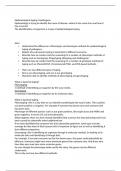Epidemiological typing of pathogens.
Epidemiology is trying to identify the cause of disease- where it has come from and how it
has occurred.
The identification of organisms is a type of epidemiological typing.
Aims
• Understand the difference in Phenotypic and Genotypic methods for epidemiological
typing of pathogens.
• Explain why sub-species typing is important in different scenarios.
• Describe how to conduct and the reasoning for a number of phenotypic methods of
typing such as: Serotyping, Phagetyping, Biotyping and Anitbiogram.
• Describe how to conduct and the reasoning for a number of genotypic methods of
typing such as: Plasmid RFLP, Chromosomal PFGE, and PCR-based methods.
• There are two different types of typing.
• One is our phenotyping, and one is our genotyping.
• Should be able to identify methods of phenotyping and genotyping.
What is bacterial typing?
Phenotyping
A method of identifying an organism by the way it looks.
Genotyping
A method of identifying an organism by its molecular data.
What is bacterial typing.
Phenotyping- this is a way that we can identify something by the way it looks. This could be
our gram positive or negative. For example if someone has brown eyes and someone else
has green eyes.
Phenotype of different species- such as our gram positives, like staph aurus and MSRA and
gram negatives, in terms of E.coli and salmonella.
What happens when you have already identified that a person has food poisoning and it has
been caused by salmonella entericatiphenerium.
If we have identified that someone has that salmonella typherium, what type of strain,
serotype do they have of that because this is important to figure out as well as identifying it
from different organisms.
Genotyping- this is identifying an organism through a molecular method. So looking at its
molecular data and identifying it through that.
For example, if you pair everyone up that has brown eyes, the genes could potentially be
different. Someone might have more dominant genes than someone else. And those who
have blue eyes may have more recessive genes.
So even though the phenotype looks exactly the same, the genes may be different
underneath.
This is why we have two different methods.
, Why is it important?
Source, routes of transmission, treatment, reserviours of infection, treatment.
After identifying that it is salmonella typhonerium, why is this extra level of information that
is needed useful.
This is because we have 2400 serotypes of salmonella typhonerium alone.
So once we have identified that it could be salmonella, there are still 2400 different types
that it could be.
It is important for us to narrow it down as to what specific strain of salmonella typhinerium
it could be because it could help treat the illness.
We want to identify the strain of salmonella to see where it has come from. For example, if
there is an outbreak at a factory for salmonella, we want to identify if loads of people are
going into hospital with salmonella, we want to trace the exact serotype of salmonella they
have just incase they are all linked to each other and we have an outbreak. So, its important
so we can trace things back.
We want to be able to find the source, we want to see the routes of transmission and the
reservoirs of infection, so how it is spreading around our communities. Whether that be in
food or farm animals and poultry. We do want to identify a treatment aswell from a clinical
perspective.
One way we can also treat patients is through prevention, by being able to find out where
that route is coming from and the source of infection, we can treat our patients before they
even get sick.
This is why it can be important to use these types of typing to identify the serotypes
specifically that are causing these infections in the patients.
Serotyping: Kauffman-white classification.
Classification for serotyping.
This is a way of classifying the organism by the way the O antigen is presented. This is on the
lipid strains in the cell wall.
It is also represented by how our H antigen is presented this is on the flagella.
The H antigen is not the amount of flagella that the salmonella has, it is the actual antigen
that is presented on that flagella that we actually look at.
This situation is for a salmonella outbreak, there are other types of serotyping for different
strains of bacteria.
The salmonella is our gram negative rod, it is rod shaped and it has loads of flagella coming
off it. Whereas a campylobacter is more of a spiral shape. Therefore, it makes sense to have
different types of serotype classifications for the different shapes of bacteria.
Slide agglutination test.
How we do this in a lab
All of the phenotype testing is normally done within a local laboratory. This is because it is a
simple test to do.
To do the serotype testing for salmonella, and this goes for other types of serotyping aswell,
we do a slide agglutination test.
Very similar to blood agglutination testing.
For the slide agglutination test if we are looking for the O antigen we will use an anti-O
antigen, this is to cause an agglutination that we can see.




